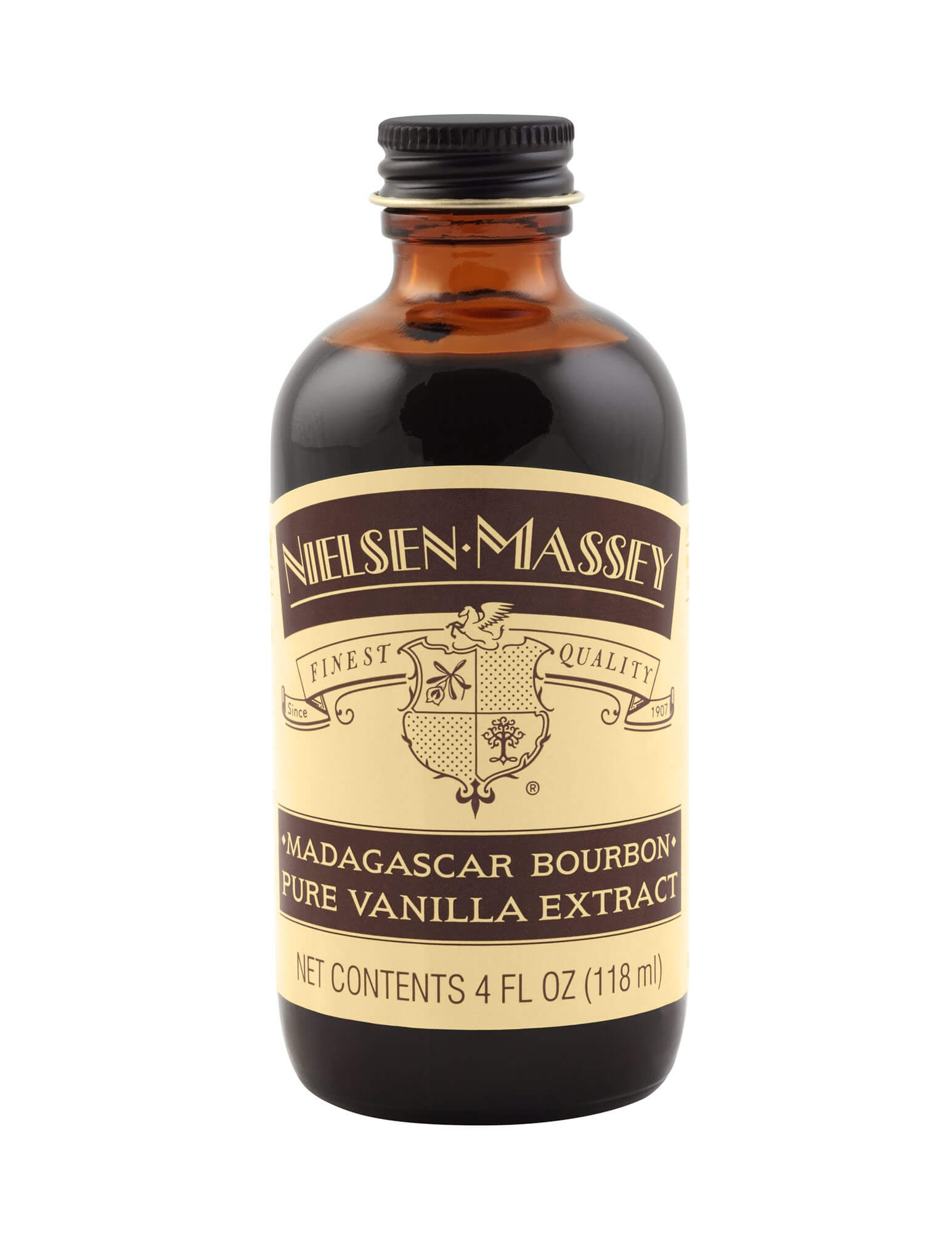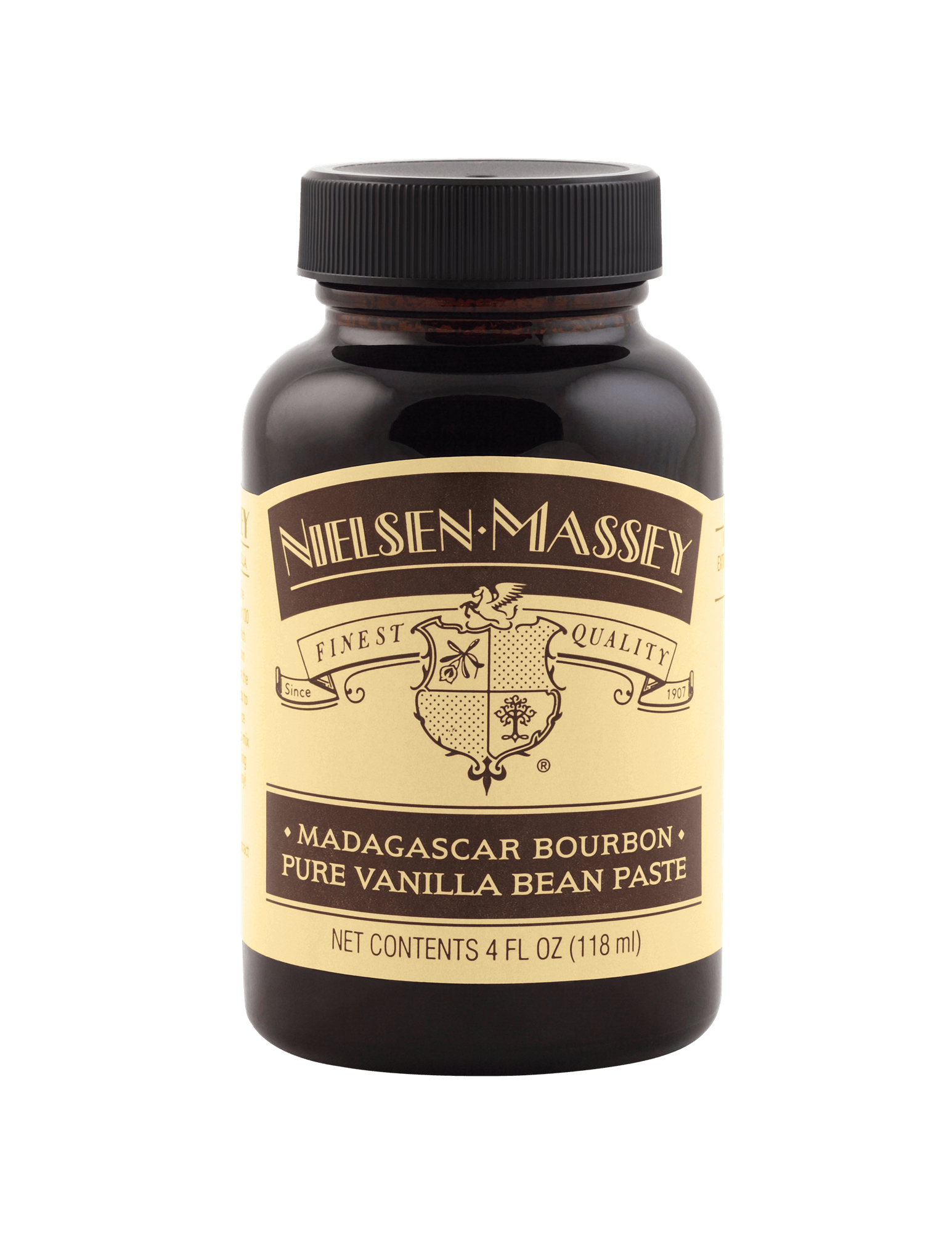Sourdough Kulich
Kulich is a Russian bread traditionally baked to celebrate Easter and the spring season. This signature dome-shaped loaf is bursting with dried fruits and nuts and topped with a sweet, vanilla icing. Our twist on the classic kulich includes using a homemade sourdough starter as the leavening agent to give it a unique, tangy flavor and airy texture.
Ingredients
Kulich bread
- 1 ¼ cups whole milk
- 2 large eggs, room temperature
- 3 ½ ounces 100% hydration sourdough starter, mature*
- ½ teaspoon instant dry yeast (optional)**
- 2 teaspoons Nielsen-Massey Madagascar Bourbon Pure Vanilla Extract
buy now - 3 ¾ cups bread flour
- 1 tablespoon granulated sugar
- 2 teaspoons fine sea salt
- 10 tablespoons butter, unsalted, room temperature
- 1 cup dried fruits (such as raisins, cranberries or a combination)
- ½ cup pecans, chopped
- 2 teaspoons lemon zest
For the icing
- 1 ½ cups powdered sugar, sifted
- 2-3 tablespoons milk, half-and-half or cream
- 1 teaspoon Nielsen-Massey Madagascar Bourbon Pure Vanilla Bean Paste
buy now - Pinch of fine sea salt
- Naturally-colored sprinkles (optional)
Directions
Bread
Soak dried fruits in hot water for 15 minutes. Drain and put aside, letting them cool to room temperature.
In a small saucepan, scald milk by bringing it to 180°F. Let cool to room temperature.
In a large bowl, whisk together milk, eggs, sourdough starter, vanilla extract and yeast, if using. Add flour and mix using a plastic scraper or your hands until dough is cohesive and shaggy, but not smooth. Cover bowl with a lint-free towel and let rest at room temperature for 30-60 minutes.
Place dough on an unfloured counter and flatten slightly. Add salt and sugar to the top and fold the dough in half. Add butter to the top and fold in half again. Begin smearing the dough down and outward on the counter using the heel of your hand until flat. Use a bench scraper to scrape everything back into a mound and repeat for 1-2 minutes, or until the ingredients are blended. The dough will still feel slightly grainy.
Knead the dough using the “French fold” method. Pick the dough up by the sides, slap the front of it back down onto the counter, fold the back half of the dough (closest to you) over the top edge of the dough, give the dough a quarter turn, and repeat. Do not flour your work surface at any point. As the dough develops, it will become less sticky and more cohesive. Occasionally, use a bench scraper to scrape everything back to the center. Continue kneading for 15 minutes, until the dough holds together and is elastic.
Add rehydrated fruits, pecans and zest. Continue folding for another 5-10 minutes until fully kneaded. Use the windowpane test to check if the dough is fully kneaded. Pinch off a small amount of dough and stretch it until it’s so thin that it’s almost transparent. If it doesn’t rip, the dough is ready.
Shape dough into a ball and place in a large bowl. Cover with plastic wrap and let rise at room temperature for one hour, then let rest in the refrigerator overnight or up to 12 hours.
Remove the dough from the refrigerator and scrape onto an unfloured counter. Lightly flatten dough, begin pulling one edge of the dough up and towards the middle, pressing the dough lightly into the center. Rotate dough slightly and pull another edge of the dough up and towards the middle, pressing together lightly. Repeat steps until all edges have been folded over. Some of the edges will overlap. Flip the dough over and shape into a tight ball by cupping your hands around the outside of the dough and pulling the ball toward you. Rotate dough and repeat. It will slightly stick and drag on your counter as it builds tension.
Use one 6 by 4 ½-inch kulich mold, prepping with non-stick spray before using if it is a metal pan. Place dough into pan and let rise at room temperature for 3 ½ – 4 ½ hours or until it doubles in size. If you have an oven with a bread proof option, set to 80°F (27°C) and place the pan inside to proof. You can leave the dough in a warm indoor area, or inside an oven set to the bread proof option. Dough will more than double in volume. Check if the dough is ready by lightly pressing into the dough. If the dent doesn’t fill in immediately, it’s ready to bake. If the dent bounces back, proof dough another 15 minutes and test again.
Preheat oven to 375°F. Score the top of the bread from left to right and then top to bottom. Bake for about 60 minutes or until a thermometer inserted into the center of the bread reads 190°F. If bread is browning too quickly, loosely cover top with a piece of aluminum foil.
Unmold bread from pan and place on a wire rack to cool completely. If using a metal pan, leave bread in pan for 10 minutes before unmolding and cooling.
Icing
In a large bowl, whisk together powdered sugar, dairy, vanilla paste and salt. Mixture should be thick but pourable. Adjust consistency by adding more powdered sugar or dairy to achieve the right thickness.
Assembly
Once the bread is cooled, pour icing on top of the bread starting in the center and working toward the edge. Stop just shy of the edge and allow the frosting to drip down the sides of the bread. Cover with sprinkles immediately, if desired. Bread can also be wrapped tightly in plastic wrap for one day before icing and serving.
Notes:
*A 100% hydration sourdough starter is kept and fed with a 1:1 ratio of flour to water by weight. To learn more, read our guide on how to make your own sourdough starter.
**To shorten resting time, also known as fermentation time, you may add dry yeast to the recipe.
Kulich bread
- 270 grams whole milk
- 2 large eggs, room temperature
- 100 grams 100% hydration sourdough starter, mature*
- ½ teaspoon instant dry yeast (optional)**
- 2 teaspoons Nielsen-Massey Madagascar Bourbon Pure Vanilla Extract
buy now - 450 grams bread flour
- 1 tablespoon granulated sugar
- 2 teaspoons fine sea salt
- 150 grams butter, unsalted, room temperature
- 120 grams dried fruits (such as raisins, cranberries or a combination)
- 60 grams pecans, chopped
- 2 teaspoons lemon zest
For the icing
- 169 grams powdered sugar, sifted
- 2-3 tablespoons milk, half-and-half or cream
- 1 teaspoon Nielsen-Massey Madagascar Bourbon Pure Vanilla Bean Paste
buy now - Pinch of fine sea salt
- Naturally-colored sprinkles (optional)
Directions
Bread
Soak dried fruits in hot water for 15 minutes. Drain and put aside, letting them cool to room temperature.
In a small saucepan, scald milk by bringing it to 82°C. Let cool to room temperature.
In a large bowl, whisk together milk, eggs, sourdough starter, vanilla extract and yeast, if using. Add flour and mix using a plastic scraper or your hands until dough is cohesive and shaggy, but not smooth. Cover bowl with a lint-free towel and let rest at room temperature for 30-60 minutes.
Place dough on an unfloured counter and flatten slightly. Add salt and sugar to the top and fold the dough in half. Add butter to the top and fold in half again. Begin smearing the dough down and outward on the counter using the heel of your hand until flat. Use a bench scraper to scrape everything back into a mound and repeat for 1-2 minutes, or until the ingredients are blended. The dough will still feel slightly grainy.
Knead the dough using the “French fold” method. Pick the dough up by the sides, slap the front of it back down onto the counter, fold the back half of the dough (closest to you) over the top edge of the dough, give the dough a quarter turn, and repeat. Do not flour your work surface at any point. As the dough develops, it will become less sticky and more cohesive. Occasionally, use a bench scraper to scrape everything back to the center. Continue kneading for 15 minutes, until the dough holds together and is elastic.
Add rehydrated fruits, pecans and zest. Continue folding for another 5-10 minutes until fully kneaded. Use the windowpane test to check if the dough is fully kneaded. Pinch off a small amount of dough and stretch it until it’s so thin that it’s almost transparent. If it doesn’t rip, the dough is ready.
Shape dough into a ball and place in a large bowl. Cover with plastic wrap and let rise at room temperature for one hour, then let rest in the refrigerator overnight or up to 12 hours.
Remove the dough from the refrigerator and scrape onto an unfloured counter. Lightly flatten dough, begin pulling one edge of the dough up and towards the middle, pressing the dough lightly into the center. Rotate dough slightly and pull another edge of the dough up and towards the middle, pressing together lightly. Repeat steps until all edges have been folded over. Some of the edges will overlap. Flip the dough over and shape into a tight ball by cupping your hands around the outside of the dough and pulling the ball toward you. Rotate dough and repeat. It will slightly stick and drag on your counter as it builds tension.
Use one 6 by 4 ½-inch kulich mold, prepping with non-stick spray before using if it is a metal pan. Place dough into pan and let rise at room temperature for 3 ½ – 4 ½ hours or until it doubles in size. If you have an oven with a bread proof option, set to 80°F (27°C) and place the pan inside to proof. You can leave the dough in a warm indoor area, or inside an oven set to the bread proof option. Dough will more than double in volume. Check if the dough is ready by lightly pressing into the dough. If the dent doesn’t fill in immediately, it’s ready to bake. If the dent bounces back, proof dough another 15 minutes and test again.
Preheat oven to 190°C. Score the top of the bread from left to right and then top to bottom. Bake for about 60 minutes or until a thermometer inserted into the center of the bread reads 88°C. If bread is browning too quickly, loosely cover top with a piece of aluminum foil.
Unmold bread from pan and place on a wire rack to cool completely. If using a metal pan, leave bread in pan for 10 minutes before unmolding and cooling.
Icing
In a large bowl, whisk together powdered sugar, dairy, vanilla paste and salt. Mixture should be thick but pourable. Adjust consistency by adding more powdered sugar or dairy to achieve the right thickness.
Assembly
Once the bread is cooled, pour icing on top of the bread starting in the center and working toward the edge. Stop just shy of the edge and allow the frosting to drip down the sides of the bread. Cover with sprinkles immediately, if desired. Bread can also be wrapped tightly in plastic wrap for one day before icing and serving.
Notes:
*A 100% hydration sourdough starter is kept and fed with a 1:1 ratio of flour to water by weight. To learn more, read our guide on how to make your own sourdough starter.
**To shorten resting time, also known as fermentation time, you may add dry yeast to the recipe.




